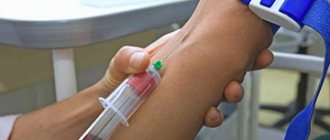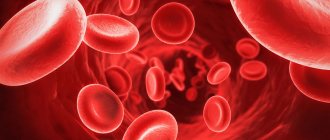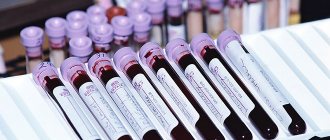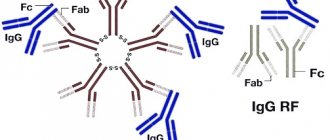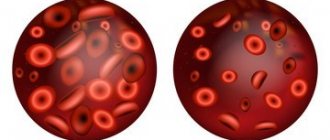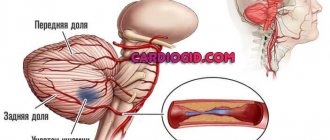When a child has difficulty stopping bleeding from a cut, or bruises often appear, you need to consult a pediatrician. It is likely that the reason is poor blood clotting. The doctor will prescribe a special test, a coagulogram, which will determine whether the child’s blood is thick enough.
Another condition that causes concern is insufficiently fluid blood. This disorder can provoke serious diseases that are best prevented at the initial stage.
Problems with blood clotting - a reason for a coagulogram
What is a coagulogram and how to take a blood test correctly?
Coagulogram is a blood test to determine its ability to clot. Too thick blood threatens the formation of blood clots, and subsequently blood clots that block the vessels. Blood cannot deliver oxygen and necessary substances to cells or remove toxins. The functioning of the immune system and thermoregulation are disrupted. Liquid blood causes severe bleeding. In critical situations, this condition can even lead to death.
In order for a coagulogram to show a reliable result, you need to prepare for it:
- The test must be taken on an empty stomach: children under 1 year of age are not fed 30-40 minutes before, 1-5 years old - 2-3 hours before, over 5 years old - 12 hours before;
- half an hour before the test, you need to avoid physical activity and stress, a small child needs to be distracted and calmed down;
- If you are taking blood thinning medications, you should notify your doctor in advance.
Blood is donated from a vein in the morning, because blood levels may change during the day. The analysis results will be ready in 1-2 days.
Reasons for the increase
If the prothrombin time is elevated, it means the blood is clotting too slowly. It's liquid. For example, you can carry out a standard calculation.
The level is calculated as the ratio of the indicator obtained from the patient to the standard average (this is 20 seconds). Let's say blood clots in 30 seconds. 30 / 20 = 1.5. With a normal index of 1.25 and even lower.
Liquid connective tissue takes longer to react than expected. There can be many reasons for this.
Liver pathologies
Organ dysfunction is accompanied by blood thinning. This occurs because this is where many clotting factors are synthesized. What diseases can provoke the disorder:
- Hepatitis. Or inflammation of the liver, usually of viral origin. Toxic, medicinal forms are possible. Those at particular risk are alcohol abusers and people who do not watch their diet.
It takes time for a permanent disorder to develop. Therefore, patients can fully count on positive prognoses.
- The second possible option is cirrhosis of the liver. Acute death of hepatocyte cells and their replacement with scar tissue. The organ is not able to work as it should. Hence the gradual decline in the synthesis of coagulation factors.
Treatment. Hepatoprotectors in large dosages plus diet. Cirrhosis in the early stages and in subcompensation requires an organ transplant. Transplantation at later stages is no longer possible. Since the blood becomes too liquid, death cannot be avoided during the operation.
Treatment with antiplatelet agents and anticoagulants
If the patient takes such drugs for a long time, problems with coagulation and an increase in PTT cannot be avoided. This is quite normal, since this is the main effect of these medications.
It makes sense to reduce the dosage if even the slightest injury or cut causes unstoppable bleeding.
Attention:
During therapy, you need to constantly monitor how prothrombin reacts and what the coagulation rate is. Every week, give or take.
Treatment. Drug dose control. If the individual reaction of the body manifests itself in excessive blood thinning, the course of therapy needs to be reconsidered.
It is possible to prescribe other medications. However, this should be done by a specialist. You cannot change medications without permission.
Vitamin K deficiency
A low concentration of the substance in the blood immediately affects the synthesis of prothrombin and an increase in blood clotting time. In general, at first glance, no changes are noticeable. However, the clotting factor is defective.
Vitamin K itself is not included in prothrombin. It works as a kind of catalyst. Accelerates normal synthesis, “packs” the substance. Gives it a finished, functionally active look. If there is a deficiency, prothrombin is not able to perform its tasks.
Treatment. Heavy doses of vitamin K. However, this is not enough. It is necessary to find the cause of the pathological process.
The nutritional factor is not always the leading one. Often the problem is the absorption of the substance in the digestive tract. Therapy is to correct the underlying factor.
Impaired synthesis of fibrinogen and other coagulation factors
Generalized problem. Such deviations develop for several reasons. This includes possible diseases of the liver, kidneys, and digestive tract.
Usually these conditions are not noticeable enough to motivate the patient to go to the hospital. At least in the early stages.
Therefore, prothrombin testing provides an invaluable service. Allows you to detect the disorder at the initial stages and treat the patient.
Therapy. Depends on the situation.
Hereditary pathologies
The classic disorder of this type is hemophilia. However, there are others. Associated with changes in the synthesis of other coagulation factors.
As a rule, such pathological processes are transmitted in a recessive manner. That is, in order for the disease to manifest itself in a patient, the damaged gene must be present in both the mother and father at the same time.
Such problems can be detected on the approaches. Even while planning pregnancy. If you get tested by a geneticist.
Treatment. Typically symptomatic. It is impossible to radically influence what is encoded at the core of the organism.
Hemostatic drugs are prescribed in medium or high dosages. Depending on how severe the disease is.
Also, such patients should behave with caution in everyday life. In order not to create unnecessary risks, do not provoke bleeding.
Blood transfusion
In this case, a temporary condition develops. Formally, it cannot be called a disease. The fact is that plasma and red blood cells are transfused. They are pure, meaning they do not contain clotting factors. This is necessary to prevent the substance from being rejected and coagulating too quickly.
The disorder lasts for several days. All this time, doctors carefully monitor the patient to avoid complications. Then everything returns to normal by itself when the liver begins to synthesize prothrombin.
Treatment. No therapy is needed as such. Doctors monitor vital signs. Including from the blood picture. If necessary, hemostatic drugs are used.
Next, the patient is transferred to inpatient treatment and discharged from the intensive care ward.
Hormonal imbalances
In particular, insufficient concentration of thyroid substances. Hyperthyroidism does not always provoke an increase in prothrombin time; only advanced forms are capable of this.
In some cases, the lack of estrogen in women and androgens in men affects it. Specific sex hormones. But here, as a rule, the background is completely disrupted.
Treatment consists of correcting the amount of substances.
- For diseases of the thyroid gland, a diet is indicated, iodine preparations are administered.
- If a tumor is to blame, it is removed after being examined in the laboratory.
- For recovery from pathologies of the adrenal glands, etc., replacement therapy is indicated.
Duration - until the disorder is permanently eliminated. The test is carried out, among other things, by laboratory methods. Monitor prothrombin time.
Endocrine diseases
First of all, it is diabetes mellitus. The process during which insulin synthesis is disrupted. Or tissue sensitivity decreases.
The disease is severe and is accompanied by dysfunction of all organs and systems. These include blood vessels, liver, and lipid metabolism. And through them, blood clotting is disrupted, and the healing time of wounds increases.
Treatment. Low glucose diet. Also systematic administration of insulin. According to need.
Malignant tumors
Any localization. They provoke a disorder, most often, at the final stages of development. The breakdown products of neoplasia poison the body and inhibit liver function. This is fraught with a disorder in the synthesis of coagulation factors.
The same should be said about metastatic cancer; it always provokes an increase in prothrombin time.
Treatment. Total tumor removal. If this fails, you need to eliminate as much of the affected area as possible. Chemotherapy and radiation therapy are then prescribed. As a second line technique.
Indications for coagulogram
This article talks about typical ways to solve your issues, but each case is unique! If you want to find out from me how to solve your particular problem, ask your question. It's fast and free
!
- preoperative or postoperative period;
- persistent bleeding;
- hereditary blood diseases;
- autoimmune diseases;
- varicose veins, thrombosis;
- burns, injuries;
- frequent occurrence of hematomas;
- taking medications that affect blood clotting;
- liver pathologies;
- infectious diseases;
- diseases of the cardiovascular system.
Why is prothrombin high?
If prothrombin according to Quick is increased and its value is 150% or more, then there may be many reasons for this:
Diseases in which the activity of vitamin K decreases several times.
A syndrome called DIC.
Various pathologies acquired during life or hereditary, for example, amyloidosis, nephrotic syndrome, etc.
Increased prothrombin may also occur if you have taken the following medications for a long time:
Antibiotics or anabolics.
Aspirin.
Diuretic drugs.
Main indicators of blood clotting and their features in children
How does blood clotting occur?
- APTT (activated partial thromboplastin time) is the most important parameter of coagulation. This is an indicator of the effectiveness of stopping bleeding. The value is directly related to violations of other normative indicators of the coagulogram. The level of fibrinogen regulates the blood clot that forms at the site of vessel damage.
- PTI (prothrombin index) directly indicates a coagulation disorder in a child. This parameter is now considered obsolete and the INR (International Normalized Ratio) is used instead.
- PO (prothrombin ratio) is the opposite parameter to PTI.
- PTT, or prothrombin time. Shows how long it takes for a blood cell clot to form at the site of injury.
- Clotting time is the period between the disruption of the integrity of the blood vessels and the cessation of bleeding.
- Thrombin time is the duration of the conversion of fibrinogen into fibrin, which promotes the formation of a blood cell clot at the site of injury.
- Time and activated time of recalcification (VRP and AVR). They show the overall clotting activity and the duration of fibrin formation in plasma.
- Lupus anticoagulant. Determined in the presence of autoimmune diseases, normally absent.
- D-dimers remain after the destruction of blood clots and reflect the functioning of the coagulation system.
- Platelets (we recommend reading: why are platelets in a child’s blood elevated?). Supports normal blood clotting processes.
- Antithrombin-III is a protein that is a natural anticoagulant.
The importance of determining PTI during pregnancy
Any woman carrying a baby is required to undergo a coagulogram, with the help of which the value of the prothrombin index is determined. This is necessary in order to avoid severe blood loss during delivery or to prevent blood clots.
The PTI norm established for expectant mothers is 85-152%. When there is a decrease in PTI, if the data shows 80% or less, there is a serious threat for bleeding. In this case, coagulants are prescribed. Accordingly, if the coefficient is increased, you will need drugs that can help eliminate increased blood clotting.
It is also necessary to determine prothrombin time. Why is this so important?
When the doctor knows over what time period the blood clots in a woman in labor, he will be able to avoid:
- the appearance of bleeding;
- the occurrence of hemolytic shock, which is the result of severe blood loss and because of which women often die during childbirth.
Some pregnant women refuse to follow medical recommendations, being confident that taking a large number of tests has a negative impact on their health. However, without information about the magnitude of the PTI, the doctor will not be able to provide timely assistance. If the index is low, the placenta may detach or postpartum hemorrhages may begin. Placental vascular thrombosis cannot be excluded if the indicators increase.
Table with norms for children
Experienced specialists should carry out a coagulogram and decipher it.
The table shows the blood clotting norms characteristic of a child:
| Index | Normal in childhood |
| Platelets | 131-402 thousand in 1 µl |
| Clotting time | 4-9 min |
| Fibrinogen | 5.9-11.7 µmol/l |
| Thrombin time | 30 min (allowable 3 min error) |
| Fibrinogen B | Absent |
| Prothrombin index (PTI) | 70-100% |
| APTT | 24-35 sec |
| D-dimer | 33-726 ng/ml |
| Antithrombin III | 70-115% |
| Lupus anticoagulant | Absent |
| Fibrinolytic activity | 180-260 sec |
| AVR | 50-70 sec |
| Duke bleeding time | Less than 4 min |
| Plasma recalcification time | 90-120 sec |
| Thrombotest | IV-V degree |
| Plasma tolerance to heparin | 3-11 min |
| Fibrinogen concentration | 1.25-4 g/l |
| RFMK | No more than 4 mg per 100 ml |
In some cases, a slight deviation from the norm in the child’s blood is not dangerous and can be corrected. In other situations, it signals the presence of an illness and requires a thorough examination of the baby.
The norms for indicators for children of different ages may vary slightly; a doctor should analyze them.
What does a low PTI level indicate?
In cases of taking anticoagulants, the PTI level can drop to 45-40%. If there is a risk of blood clots, the dose of these drugs is controlled by a doctor. After increasing or decreasing the dose of the drug, an IPT test must be taken. The norm for such patients is determined by the attending physician. If the prothrombin index has decreased not while taking anticoagulants, then this may indicate, for example, vitamin K deficiency, serious diseases of the liver or gastrointestinal tract as a whole, and in pregnant women before childbirth - the risk of bleeding during labor.


